newhorizons
Latest

Backlit Pluto photo shows evidence of possible clouds
Can't get enough of the ninth planet-no-longer in our solar system? Neither can NASA, which continues to receive images that its New Horizons spacecraft took on its Pluto flyby last year. One shot on July 15th caught the dwarf planet backlit by the sun, which revealed never-before-seen atmospheric phenomena that might just be the first evidence of clouds.

USPS debuts stamps with New Horizons' view of Pluto
To honor NASA's discoveries, the USPS is debuting new stamps today with images from outer space. The "Views of Our Planets" series will get new images of Mercury, Venus, Mars, Jupiter, Saturn, Uranus, Neptune and the iconic "blue marble" view of Earth. Thanks to the New Horizons mission to Pluto, there's a special set of two stamps with a snapshot from July's flyby and the spacecraft itself. The eight new planet stamps are available at post offices and online, but the Pluto stamps will be sold only on the web. If you're looking to add a few to your collection, the entire set is available starting today.
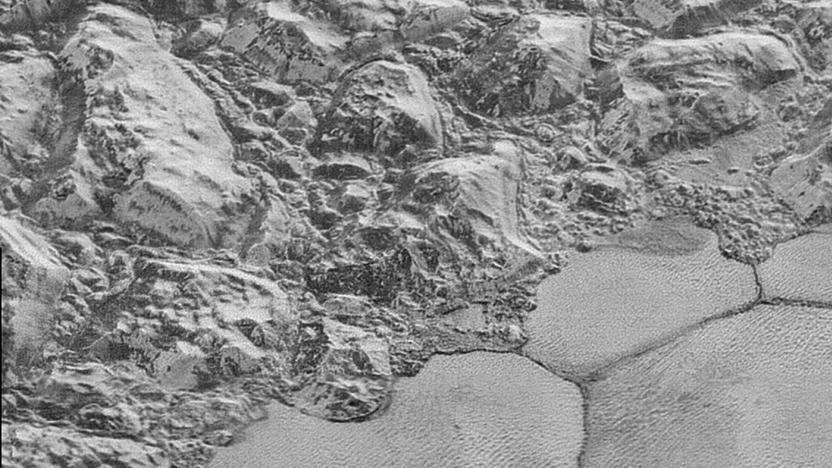
NASA gets a better picture of Pluto's surface
Back in December, NASA shared its best Pluto close-ups gathered by New Horizons. It was a detailed, but incomplete set -- now, the plucky probe has transferred more data back to Earth, allowing researchers to stitch together the rest of the picture. The new "mosaic strip" covers a larger part of Pluto's surface -- a diagonal segment crossing the face of the dwarf planet while New Horizons flew by on July 14th, 2015. You can take a look at the full image here, or watch a brief tour video NASA has put together.

NY Times sends 300,000 Google Cardboard viewers to subscribers
After last year's rollout of the NY Times VR app, the 165-year-old paper is sending out another 300,000 Google Cardboard kits to digital subscribers. This year's promotion coincides with the release of the Times' new virtual reality film "Seeking Pluto's Frigid Heart." The film actually debuted earlier this month at the Tribeca Film Festival but will hit the NY Times VR app on May 19th. When it lands, users will be able to virtually fly over the "rugged mountains and bright plains," or stand on the surface of the dwarf planet while the moon Charon hangs in the sky. The film is a joint project between the newspaper, the Lunar and Planetary Institute and the Universities Space Research Association, and the data used to create the virtual Pluto was gathered in 2015 by NASA's New Horizons spacecraft. The Times will be selecting Cardboard recipients based on how long they've been subscribers, so if you're just signing up today for a trip to Pluto, chances are you'll get left behind. Don't fret, though: You can still catch a modified 360-degree video version when it drops in May.
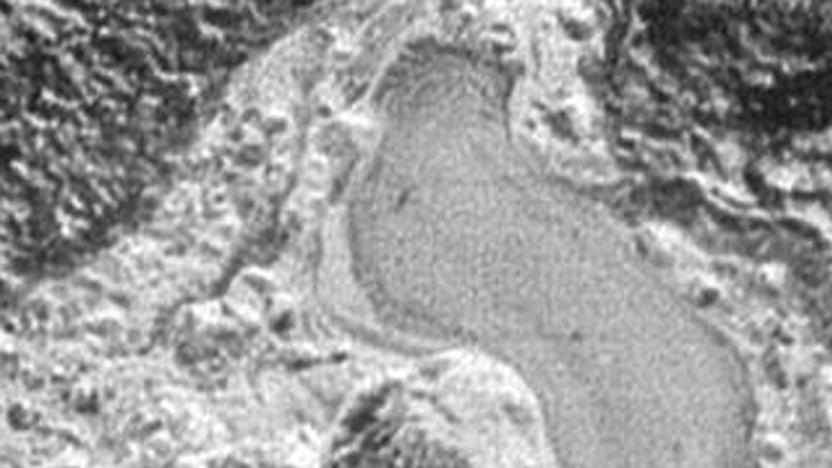
New Horizons spots signs of a former lake on Pluto
The New Horizons probe isn't just revealing details of Pluto's highest heights... it's also uncovering some of the dwarf planet's hidden history. NASA has published an image form the spacecraft showing evidence of a former frozen lake. The remnants are relatively small (20 miles across at their widest), but the surrounding channels hint that the lake held liquid nitrogen at some point in the distant past. While we'll need more data to draw any firm conclusions, this suggests that Pluto was considerably livelier "millions or billions" of years ago -- it wasn't the wasteland it appears to be today.
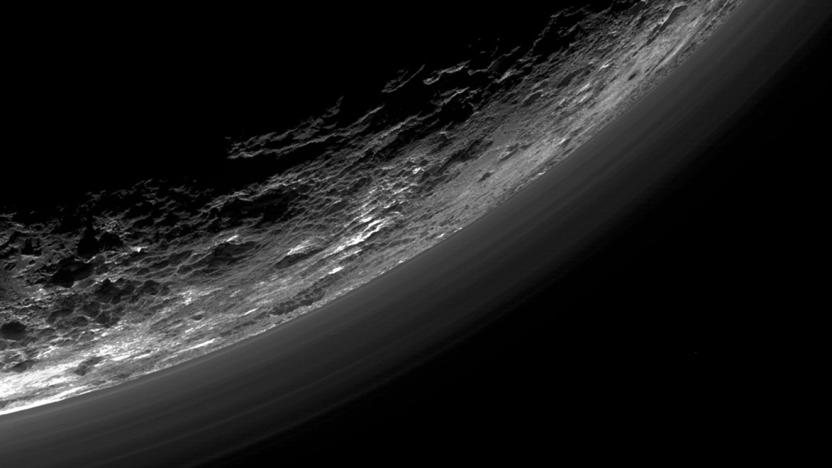
New studies detail just how complex Pluto and its moons are
Before New Horizons started sending back data and close-up images of Pluto, we barely knew the dwarf planet. We were like a love-sick fool who could only observe from afar. Now, the New Horizons scientists have enough material to publish five new papers that detail the probe's findings on the dwarf planet and its moons in Science. One of its most important discoveries is that Pluto has been geologically active for 4 billion years. Its heart-shaped region's western lobe, the Sputnik Planum, however, is relatively young at only 10-million-years-old.

New Horizons spots snowcapped peaks on Pluto
Right now, most mountaineers covet the seven summits: the highest peaks on each continent. In the (very, very distant) future the big seven might be redefined as the highest peaks across the solar system. A whimsical thought, perhaps, but a newly-discovered mountain range on Pluto will have even the most amateur of Earth-based climbers intrigued. The frosty-looking peaks are located in the south east of a region known as Cthulhu, and stretch out over 260 miles in length.

USPS' 2016 stamps celebrate Pluto's exploration
The US Postal Service now has an answer to its 1991 "Not Yet Explored" Pluto stamp, the same one the New Horizons team affixed to their probe before it started its journey to the dwarf planet. These new stamps for 2016 feature an artist render of the history-making spacecraft, as well as the most popular image it took of Pluto. The composite photo, which clearly shows Pluto's heart-shaped region, was captured by the probe's Long Range Reconnaissance Imager (LORRI) during its closest approach.

Pluto gets rainbow-hued in NASA's latest images
Pluto may have been imaged six ways from Sunday, but it's clear that the New Horizons probe still has a few surprises up its sleeve. NASA has posted both a photo and a video showing how the spacecraft can produce vibrant colors from the seemingly drab-looking dwarf planet. The key is New Horizons' infrared spectrometer. Its linearly-varying filter produces a stained glass window effect as it looks for reflected chemicals, like in the clip you see below -- the dark bands come when Pluto's methane ice absorbs those materials. And when researchers plug the results into visible color channels, the result is the almost festive mix of red and green (with hints of blue) that you see above.

Watch Pluto's mesmerizing space weather
Ever wondered what the cosmic weather is like, especially around more distant worlds? NASA's happy to help. It recently published a simulation of the Solar System's weather (specifically the Sun's flares, winds and other behaviors) around the time New Horizons swung by Pluto. The color-coded imagery, which reflects the density, pressure and temperature of outgoing plasma, is more than a little hypnotic -- the plasma slowly spirals out, with coronal mass ejections creating shockwaves (the blue you see above) that travel to the farthest reaches of the system.
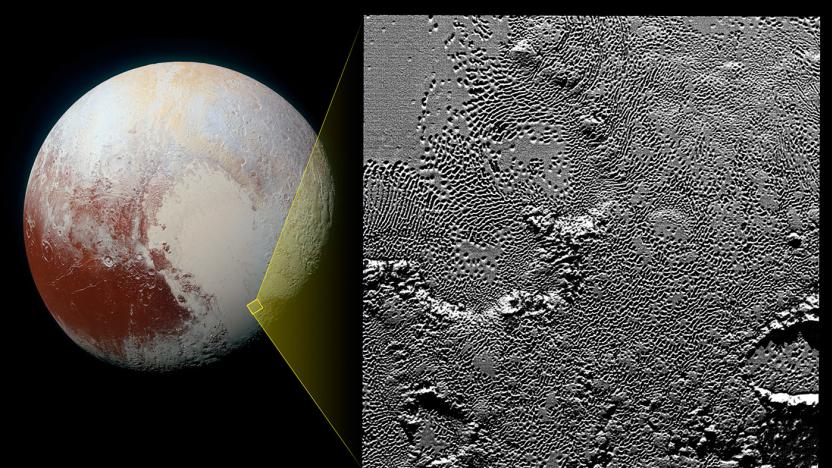
NASA releases an even closer look at Pluto's heart
Now that you're better acquainted with Pluto's mountains and ice fields, it's time to examine its heart. We're talking about the dwarf planet's heart-shaped region called Tombaugh Regio, of course, which is prominently displayed in many of its most famous images. During New Horizons' closest flyby in July, the probe's Long Range Reconnaissance Imager (LORRI) zoomed in on the area and took photos within 9,550 miles of its surface.

This is your closest look yet at a Kuiper Belt object
That moving dot you see in the picture above may not seem like much at first glance, but it's a pretty big deal -- it's humanity's closest-ever look at an object in the Solar System's distant Kuiper Belt. NASA's New Horizons spacecraft recently caught 1994 JR1 on camera from "just" 170 million miles away, or 15 times closer than any Kuiper Belt object has been seen before. That's no mean feat when the celestial body is a whopping 3.3 billion miles away from the Sun, putting it beyond Pluto's current position and into the realm of even tinier dwarf planets like Haumea and Makemake.
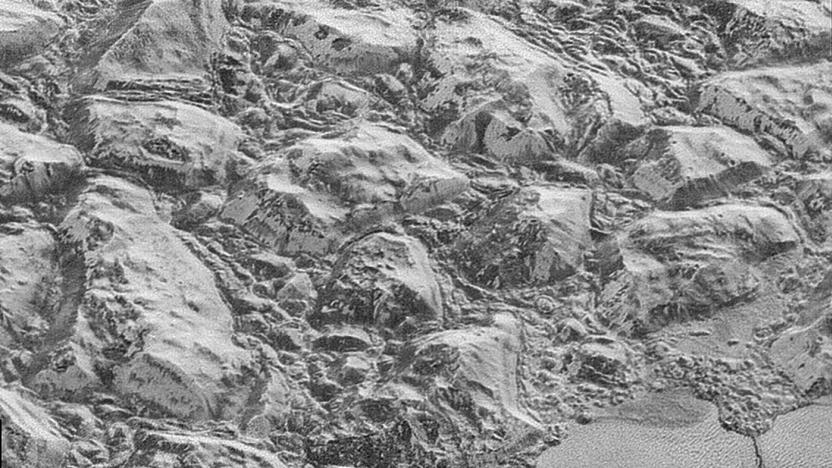
NASA shows the sharpest ever close-up photos of Pluto
I can practically hear you groan -- more Pluto photos? Well, these are kind of special: they're the sharpest pictures the New Horizons probe took during its closest flyby in July, and NASA believes these may be the best snapshots of the dwarf planet we'll see for decades to come. These series of images captured by the spacecraft's Long Range Reconnaissance Imager (LORRI) from 10,000 miles away have a resolution of 250 to 280 feet per pixel. That makes them, according to the agency, six times better than the global Pluto map it released earlier. When stitched together, those photos form a 50-mile strip full of craters, ice fields and mountains that show up so clearly, it's as if they merely display one of the polar regions filmed from aboard a helicopter.
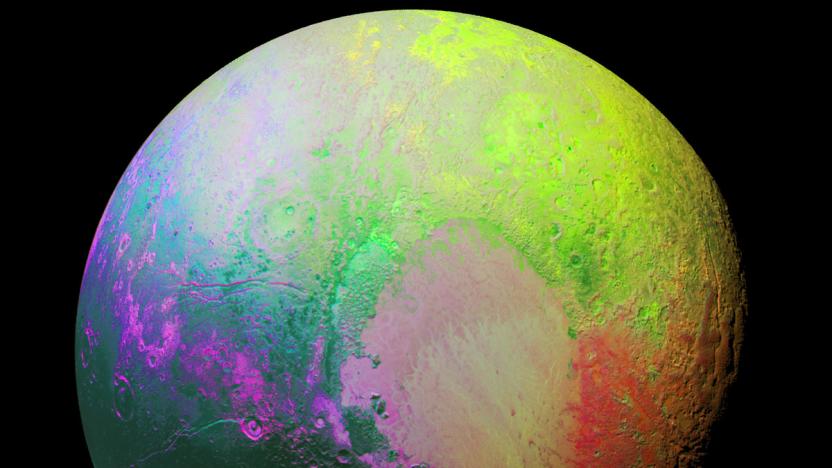
The Big Picture: A psychedelic portrait of Pluto by New Horizons
No, you're not tripping. This is really Pluto -- it's just dressed in hues much more exciting than its usual cream, white, gray and copper. Think of this color scheme as the dwarf planet's mardi gras outfit, and the tamer ones as its office suits and classic dresses. The New Horizons team used a technique called principal component analysis to process the images taken on July 14th by its spacecraft's Ralph/MVIC camera. Their goal is to amplify the subtle shade differences between Pluto's regions, and seeing as the final product looks like a psychedelic world with several distinct colors, we'd say it was a success.

New Horizons is now on track to explore the outer solar system
After snapping beautiful images of Pluto, New Horizons has set its sights on an ancient body in the Kuiper Belt. The space probe has completed the last of four maneuvers and is now on course for "2014 MU69" with an expected interception date of January 2019 (if the project gets NASA's seal of approval). As glorious as a trip into the unknown would be, even just executing these targeting burns is an impressive effort considering how far away from Earth the probe is. "This is another milestone in the life of an already successful mission that's returning exciting new data every day," said Curt Niebur, New Horizons program scientist at NASA Headquarters. "These course adjustments preserve the option of studying an even more distant object in the future, as New Horizons continues its remarkable journey."

New Horizons parts Pluto with a shot of its puniest moon
NASA's New Horizon's spacecraft has done yeoman's work at Pluto, having taken stunning images of the ex-planet and its major moon Charon. Now it's taking off for the largely unseen Kuiper belt, but it grabbed one last image of the tiny moon Kerberos before leaving. It turns out that the body is smaller than thought at around 8 miles across, and consists of two distinctive "lobes." Much like Comet 67P orbited by the ESA's Rosetta spacecraft, the unusual shape of Kerberos may be the result of a collision between two smaller objects. Like Pluto's other small moons, and several spots on the quasi-planet itself, it's also coated with "relatively clean water ice," making it highly reflective.

Recommended Reading: iPhone 6s in the hands of a pro photographer
Recommended Reading highlights the best long-form writing on technology and more in print and on the web. Some weeks, you'll also find short reviews of books that we think are worth your time. We hope you enjoy the read. iPhone 6s Camera Review: Switzerland by Austin Mann Still on the fence about all of those camera features on the iPhone 6s? Professional photographer Austin Mann has taken previous Apple handsets for a test-drive and he's done the same with the latest. From Live Photos to handy accessories and low-light performance, Mann details the phone's photography abilities while touring Switzerland.

ICYMI: Smart measuring leggings, 3D-printed Adidas and more
#fivemin-widget-blogsmith-image-421397{display:none;} .cke_show_borders #fivemin-widget-blogsmith-image-421397, #postcontentcontainer #fivemin-widget-blogsmith-image-421397{width:570px;display:block;} try{document.getElementById("fivemin-widget-blogsmith-image-421397").style.display="none";}catch(e){}Today on In Case You Missed It: LikeAGlove's new smart leggings that measure your body, then match you to the perfectly-fitted pair of jeans just went on pre-sale for $40. A new camera that reminds us of Lytro because of post-photo focusing abilities uses spider eyes as inspiration for its rig of 16 lenses with different focal lengths. But, it'll cost you at least $1,300. So soak that in for awhile. Meanwhile Adidas wants to 3D-print midsoles that are designed specifically for customer's foot contours.

NASA finds that Pluto has blue skies and surface water ice
Move over Mars, NASA's just confirmed that Pluto, everybody's favorite Kuiper belt object/celestial punching bag, not only has expansive fields of water ice on its surface but blue skies as well. Granted Pluto has neither the thick atmosphere nor global oceans that the Earth does, so the "blue sky" NASA's New Horizon's team spotted last week is actually more of a haze. And, technically, the haze particles themselves would likely appear either red or grey to the naked eye. However, the fact that they appear blue from this distance tells NASA a lot.

The Big Picture: NASA shows off Pluto's largest moon
As the long, slow download of data from the New Horizon's mission continues, NASA has posted some new high-res enhanced color pictures of Pluto's largest moon, Charon (shown above in the upper left corner). Other than a reddish polar region, the images also reveal a surprisingly detailed landscape with canyons, mountains and more. A video composite of images (embedded after the break) takes us flying over a canyon NASA says is four times as long as the Grand Canyon, and twice as deep. NASA says even better pictures are on the way, although with the spacecraft 3.1 billion miles away and still going, we'll be waiting a year to get everything.










